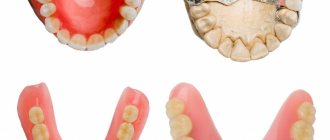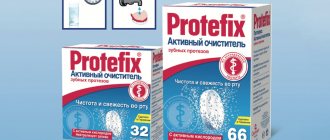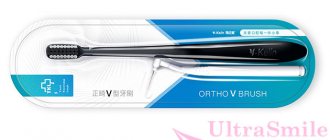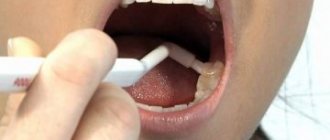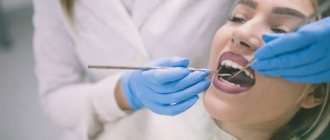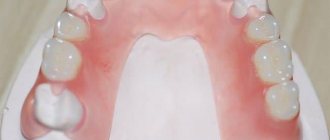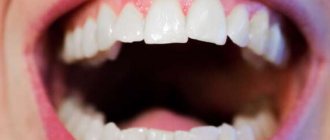Cleaning before braces: why is it needed?
Correction of the bite always begins with sanitation of the oral cavity. In addition to treating diseases of the teeth and gums, it includes mandatory professional cleaning before installing braces. The doctor will remove hard deposits with ultrasound, and soft deposits with a thin and powerful jet of cleaning powder solution (AirFlow technology). After this, the teeth will need to be polished with a special paste and coated with a fluoride-containing preparation to strengthen the enamel. Such a hygienic procedure should be carried out 3 - 5 days before installation, but no later than 24 hours.
What happens if you don’t brush your teeth before braces? Bacterial plaque will get under the elements of the system, in particular under the clasps that are glued to the enamel. Considering that orthodontic appliances are worn for a year at best, and two years on average, microorganisms will have enough time to multiply and lead to the formation of caries. It is impossible to properly cure it with braces on the teeth. There is a risk of early removal of the device, and this will spoil the final result, and the patient will waste money, time and moral strength. This is why brushing your teeth before getting braces is mandatory.
How to properly glue wax to braces
Wax for braces helps reduce discomfort and pain, saving mucous membranes from chafing. It is harmless to the body and does not cause allergies. In addition to wax, special silicone is used to care for braces. It holds better, lasts longer than wax and is also safe.
To apply wax or silicone correctly, follow the instructions.
- Identify
all problem areas. - Clean
thoroughly . - Dry
the area where silicone or wax is applied. - Cut
or tear off a small piece of silicone or wax. - Warm
a little and roll it into a ball. - Attach
the ball to the orthodontic archwire or clasp that is causing pain - the wax should protrude slightly in front of the brackets. - Press
well on the ball to secure it firmly. - Repeat
this on all problem areas. - renewed
during the day .
If you accidentally swallow such wax or silicone, nothing will happen, but it is better not to do it.
Rules for caring for braces after installation
And finally, the orthodontic structure is put on. There are many months, or even years of treatment ahead, during which you will need to devote a lot of time to oral hygiene. Cleaning braces is not an easy task. An orthodontic apparatus is a complex system with many elements: clasps, arches, ligatures, rings, springs, hooks for elastic rods... And on each of them food particles can remain and plaque can accumulate.
Recommendations for caring for the braces system
- You need to brush your teeth at least three times a day, and ideally after every meal, even a small snack.
- It is necessary to brush not only your teeth, but also between them. Dental floss will help clean the interdental space.
- The hygiene of braces must be the most thorough: all elements of the system will have to be processed on each side, avoiding the accumulation of plaque.
- You will have to purchase special brushes for cleaning braces, as well as additional devices such as an irrigator. We will talk about this in more detail below.
- To clean the braces system and teeth, a fluoride-containing paste is used, as well as a fluoride-containing rinse, which completes the oral hygiene procedure with braces.
- It’s best to always carry a toothbrush and floss with you in case you need to eat out.
- For those who wear braces, care and nutrition go hand in hand. During treatment, you will have to give up a number of foods—hard, sticky, fibrous, and anything else that could damage your braces or get stuck in them. You should also significantly limit sweets.
Hygiene of the brace system is a key task for the entire period of wearing an orthodontic device. If it is neglected, whitish spots may appear on the enamel of the teeth - traces of demineralization and the accumulation of bacterial plaque. They look unaesthetic and spoil the impression of the results of long-term treatment.
How to floss with braces[5]
When using any type of dental floss, you must follow the correct sequence of actions.
- The thread is passed under the wire of the orthodontic structure and brought out from the opposite side of the dentition. In superfloss, pushing is helped by the first dense section; for regular thread, it is convenient to use a special needle threader. This is an inexpensive, disposable device that is usually sold in the same place where dental floss itself is sold.
- A thread 30-40 cm long is wound around the middle fingers. Use the thumb of your right hand and the index finger of your left to adjust the tension.
- The thread is carefully inserted into the space between the teeth, pressing it against the wall of one of them. It is important to control the depth of immersion so as not to damage the soft gum tissue and dislodge the braces.
- It is necessary to perform 4-5 movements back and forth and up and down.
- The floss is then removed and moved to the next tooth using a clean section of floss.
Hygiene products for braces
When a person wears braces, oral care consists of several stages. Each of them has its own tool, so the patient will have to acquire a whole arsenal of hygiene products.
Brush for cleaning teeth with braces
The orthobrush has a V-shape with a depression in the center of the pile, which is necessary for treating the surfaces of teeth and most of the orthodontic apparatus. This is where teeth cleaning with braces at home begins. Orthodontists also recommend purchasing a single-tuft toothbrush for cleaning braces. It will be useful for processing distant teeth and the outer part of locks.
Brushes for cleaning braces
It is also necessary to use brushes to clean braces. With their help, it is easy to clean the dental surface under the arcs of the device.
Superfloss
For oral hygiene with braces and cleaning the space between the teeth and around the clasps, you will need a special thread with a hard end - superfloss.
Oral irrigator
Separately, it is necessary to mention the most important device for cleaning braces - the irrigator. The device is somewhat similar to an electric toothbrush, but instead of bristles it has a nozzle from which a powerful stream of water is supplied. The irrigator helps clear plaque from hard-to-reach places where brushes and brushes cannot reach (for example, gum pockets).
Strengthening toothpaste
Wearing braces significantly increases the risk of caries. Therefore, it is worth thinking about prevention. Toothpastes with fluoride, hydroxyapatite crystals, theobromine and other strengthening substances will make your teeth stronger.
Regular toothbrush
A regular brush, which is sold in any store, removes plaque on the outside and inside of the teeth.
Moving the brush in a circular or up-and-down motion can push plaque under the gum and cause inflammation.
If you brush your teeth with horizontal movements to the right and left, the interdental spaces are poorly cleaned and there is a high probability that the gingival surfaces of the teeth will remain uncleaned. The result is inflammation of the interdental papillae and caries on the contact surfaces of the teeth.
How to brush your teeth correctly? It is necessary to hold the brush horizontally and, using sweeping movements from the gums to the cutting edge, clean off plaque from the outside of the dentition of both jaws. Then, placing the brush vertically, brush the inside of the teeth, also from the gums to the cutting edge. Then brush the chewing surfaces of your teeth as usual. At least 10 cleaning movements should be performed on each surface of each tooth.
Why do you need to have your braces cleaned at the dentist?
No matter how thoroughly you clean your braces at home, it is impossible to 100% remove plaque accumulated in hard-to-reach places. This is why patients undergoing orthodontic treatment are recommended to have their braces professionally cleaned at least once every 6 months, and ideally once every quarter. It needs to be scheduled in the same way as regular visits to the orthodontist to monitor and correct the system.
Professional cleaning of teeth with braces is carried out according to the same scheme as in all other cases, but requires greater care from the doctor. Using the AirFlow device, the hygienist removes plaque, paying special attention to the areas around the locks. If necessary, ultrasound is also used to remove hard deposits in the pregingival zone (ultrasound cannot be used around elements of the orthodontic apparatus). After completing the procedure, it is worth carrying out surface fluoridation of the teeth to strengthen the enamel.
Professional hygiene will help avoid the appearance of whitish spots on the surface of the teeth. Therefore, to the question “Is it possible to do cleaning with braces?” we answer: “Not only is it possible, but it is also necessary!”
Brushing your teeth after removing braces
You need to be attentive to oral hygiene not only during orthodontic treatment, but also after its completion. Care after removing braces plays an important role in preventing caries. The fact is that during the process of correcting the bite, the enamel is subjected to constant pressure. Dental care after braces often includes the use of special gels, pastes and varnishes that restore enamel density and reduce sensitivity.
Professional cleaning after braces will also not be superfluous. The hygienist will remove plaque and pigment inclusions and make an application that strengthens the enamel. If there are no contraindications, after removal of the system, patients can have their teeth whitened to return them to their original snow-white shade.
Brushing your teeth after braces at home should remain just as thorough. Of course, there will no longer be a need for a whole arsenal of brushes and brushes, but brushing your teeth twice a day and using floss is a must.
What should you not eat while wearing braces?
The second most popular question concerns the diet during bite correction. Everything here is quite simple - you should limit those foods and drinks that can damage the brace system.
First of all, this is tough and solid food. Avoid chewing nuts, apples and other fruits and vegetables. It is also better to limit hot drinks, replacing them with warm ones. As for sweets, braces prohibit sticky toffee, which can get caught in the clasps and break them. Remember that after each use of sweets you need to brush your teeth or rinse your mouth. This will protect you from caries and allow you to occasionally treat yourself to sweets and chocolate.


